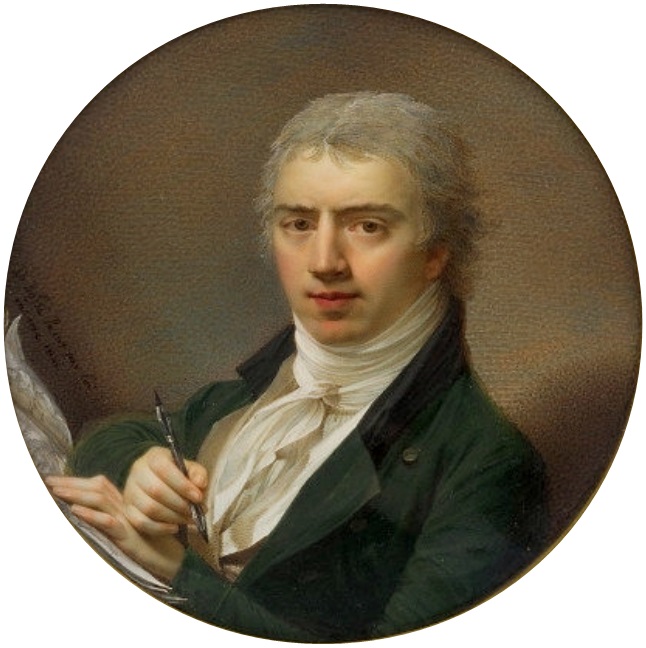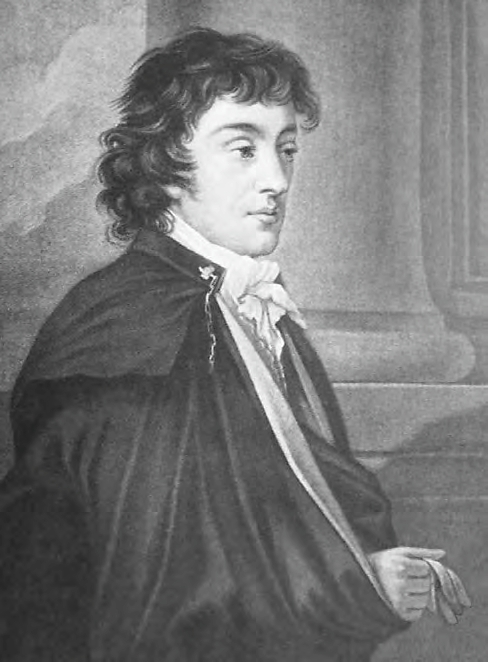|
Maria Wirtemberska
Princess Maria Czartoryska (formerly Duchess Louis of Württemberg; 15 March 1768, Warsaw – 21 October 1854, Paris), was a Polish noble, writer, musician and philanthropist. Life Maria Anna was a daughter of Prince Adam Kazimierz Czartoryski and Countess Isabella von Flemming. She spent her childhood in the Blue Palace in Warsaw and Powązki. In 1782 she moved with her parents to Puławy. Since 1784 to 1793 Maria was married to Duke Louis of Württemberg, who became the Hetman of the Lithuanian Army in the 1792 war against Russia. Maria divorced him when his betrayal of the Polish–Lithuanian Commonwealth became known. Maria's only son, Duke Adam of Württemberg, remained with his father and was raised in an atmosphere prejudiced against his mother and Poland. Following her divorce, Maria lived mostly in Warsaw, and since 1798 to 1804 spent winters in Vienna and summers at Puławy. Between 1808-1816 she hosted her literary salon in Warsaw (Blue Saturdays). Her guests ... [...More Info...] [...Related Items...] OR: [Wikipedia] [Google] [Baidu] |
Duke Louis Of Württemberg
Duke Ludwig Friedrich Alexander of Württemberg (; 30 August 1756, in Treptow an der Rega20 September 1817, in Kirchheim unter Teck) was the second son of Frederick II Eugene, Duke of Württemberg (1732–1797) and Margravine Sophia Dorothea of Brandenburg-Schwedt (1736–1798). His elder brother was Frederick I, the first King of Württemberg, and his sister was the Russian Empress consort, Maria Feodorovna. Louis retained the pre-royal title of Duke. Biography Louis Frederick was a general in the cavalry. He was briefly a high ranking commander the Army of the Polish-Lithuanian Commonwealth appointed the commander of the Grand Duchy of Lithuania's army, but betrayed the Commonwealth, refusing to fight against Russian troops throughout the Polish–Russian War of 1792, while feigning illness. For his betrayal he was dismissed from his post, but never prosecuted. His Polish wife, Duchess Maria, divorced him shortly afterward after his treason became public knowledge. Between 18 ... [...More Info...] [...Related Items...] OR: [Wikipedia] [Google] [Baidu] |
Vienna
en, Viennese , iso_code = AT-9 , registration_plate = W , postal_code_type = Postal code , postal_code = , timezone = CET , utc_offset = +1 , timezone_DST = CEST , utc_offset_DST = +2 , blank_name = Vehicle registration , blank_info = W , blank1_name = GDP , blank1_info = € 96.5 billion (2020) , blank2_name = GDP per capita , blank2_info = € 50,400 (2020) , blank_name_sec1 = HDI (2019) , blank_info_sec1 = 0.947 · 1st of 9 , blank3_name = Seats in the Federal Council , blank3_info = , blank_name_sec2 = GeoTLD , blank_info_sec2 = .wien , website = , footnotes = , image_blank_emblem = Wien logo.svg , blank_emblem_size = Vienna ( ; german: Wien ; ba ... [...More Info...] [...Related Items...] OR: [Wikipedia] [Google] [Baidu] |
Johann Dominik Bossi
Johann Dominik Bossi (1767–1853), also known as ''Domenico Bossi'', was an Italian painter. Bossi, a student of Giovanni Domenico Tiepolo, was born in Trieste and worked primarily as a miniaturist in Germany, Austria, Sweden and Russia before he settled down in Munich, where he lived at ''Theresien Straße 19'' in Munich around 1850. In Munich he was appointed a court painter A court painter was an artist who painted for the members of a royal or princely family, sometimes on a fixed salary and on an exclusive basis where the artist was not supposed to undertake other work. Painters were the most common, but the cour .... Bossi was the founder of a collection, which included a significant group of Tiepolo drawings amongst others. The collection passed to his daughter, Maria Theresa Caroline Bossi (1825–1881), and her husband, Carl Christian Friedrich Beyerlen (1826–1881). The ''Bossi-Beyerlen collection'' was sold at auction in Stuttgart and dispersed in March 1882. [...More Info...] [...Related Items...] OR: [Wikipedia] [Google] [Baidu] |
Palace
A palace is a grand residence, especially a royal residence, or the home of a head of state or some other high-ranking dignitary, such as a bishop or archbishop. The word is derived from the Latin name palātium, for Palatine Hill in Rome which housed the Roman Empire, Imperial residences. Most European languages have a version of the term (''palais'', ''palazzo'', ''palacio'', etc.), and many use it for a wider range of buildings than English. In many parts of Europe, the equivalent term is also applied to large private houses in cities, especially of the aristocracy; often the term for a large country house is different. Many historic palaces are now put to other uses such as parliaments, museums, hotels, or office buildings. The word is also sometimes used to describe a lavishly ornate building used for public entertainment or exhibitions such as a movie palace. A palace is distinguished from a castle while the latter clearly is fortified or has the style of a fortification ... [...More Info...] [...Related Items...] OR: [Wikipedia] [Google] [Baidu] |
Adam Jerzy Czartoryski
Adam Jerzy Czartoryski (; lt, Аdomas Jurgis Čartoriskis; 14 January 177015 July 1861), in English known as Adam George Czartoryski, was a Polish nobleman, statesman, diplomat and author. The son of a wealthy prince, he began his political career as a foreign minister to the Russian Tsar Alexander I after Poland was partitioned by Russia, Prussia and Austria. He later became a leader of the Polish government in exile and a bitter opponent of Alexander's successor, Tsar Nicholas I. In exile, he advocated for the reestablishment of a sovereign Polish state, which also stimulated early Balkan and Belgian nationalism, and intensified their desire for independence. Czartoryski was a dedicated patron of arts and greatly contributed to the Czartoryski Collection. In 1798, he purchased one of Poland's most important national treasures – Leonardo da Vinci's ''Lady with an Ermine'', which he brought as a gift for his mother from Italy. Early life and education Czartoryski was b ... [...More Info...] [...Related Items...] OR: [Wikipedia] [Google] [Baidu] |
Kingdom Of Galicia And Lodomeria
The Kingdom of Galicia and Lodomeria,, ; pl, Królestwo Galicji i Lodomerii, ; uk, Королівство Галичини та Володимирії, Korolivstvo Halychyny ta Volodymyrii; la, Rēgnum Galiciae et Lodomeriae also known as Austrian Galicia or colloquially Austrian Poland, was a constituent possession of the Habsburg monarchy in the historical region of Galicia in Eastern Europe. The crownland was established in 1772. The lands were annexed from the Polish-Lithuanian Commonwealth as part of the First Partition of Poland. In 1804 it became a crownland of the newly proclaimed Austrian Empire. From 1867 it was a crownland within the Cisleithanian or Austrian half of the dual monarchy of Austria-Hungary. It maintained a degree of provincial autonomy. Its status remained unchanged until the dissolution of the monarchy in 1918. The domain was initially carved in 1772 from the south-western part of the Polish–Lithuanian Commonwealth. During the following pe ... [...More Info...] [...Related Items...] OR: [Wikipedia] [Google] [Baidu] |
Sieniawa
Sieniawa (; uk, Сеня́ва, Seniáva), is a town in southeastern Poland. It had a population of 2,127 inhabitants (02.06.2009). Since 1999, Sieniawa has been part of Subcarpathian Voivodeship. History Sieniawa's history dates back to the 17th century, and the town owes its existence to the once powerful Sieniawski family. It was founded in 1676, on initiative of Voivode of Volhynia and Starosta of Lwow, Mikolaj Hieronim Sieniawski, who owned enormous estates in eastern lands of the Polish–Lithuanian Commonwealth. Sieniawa was founded in the area which was covered by the village of Dybkow. The Sieniawski family wanted to make it main administrative center of their estates. In ca. 1650, a brick fortress was built on a hill near contemporary Sieniawa. In the following years, the Sieniawski family built their manor house near the fortress, and began construction of the town, together with the San river port. A Dominican church and abbey was built, and in the 1660s, walls were ... [...More Info...] [...Related Items...] OR: [Wikipedia] [Google] [Baidu] |
November Uprising
The November Uprising (1830–31), also known as the Polish–Russian War 1830–31 or the Cadet Revolution, was an armed rebellion in the heartland of partitioned Poland against the Russian Empire. The uprising began on 29 November 1830 in Warsaw when young Polish officers from the military academy of the Army of Congress Poland revolted, led by Lieutenant Piotr Wysocki. Large segments of the peoples of Lithuania, Belarus, and the Right-bank Ukraine soon joined the uprising. Although the insurgents achieved local successes, a numerically superior Imperial Russian Army under Ivan Paskevich eventually crushed the uprising. "Polish Uprising of 1830–31." ''The Great Soviet Encyclopedia'', 3rd Edition (1970–1979). G ... [...More Info...] [...Related Items...] OR: [Wikipedia] [Google] [Baidu] |
Land Agent
Land agent may be used in at least three different contexts. Traditionally, a land agent was a managerial employee who conducted the business affairs of a large estate (house), landed estate for a member of the landed gentry, supervising the farming of the property by farm labourers and/or tenants and collecting rents or other payments. In this context a land agent was a relatively privileged position and was a senior member of the estate's staff. The older term, which continued to be used on some estates, was Steward (office), steward, and in Scotland a land agent was usually referred to as a Factor (Scotland), factor. Today the term estate manager or similar is more common. Other uses A land agent, also called a warrant agent, may also be a Real estate broker, real estate agent or broker who specialises in land and farm sales. Land and farm sales differ drastically from sales of houses, therefore there is the need for specialisation. This usage is found in the United Kingdom, A ... [...More Info...] [...Related Items...] OR: [Wikipedia] [Google] [Baidu] |
Franciszek Lessel
Franciszek Lessel (1780 – 26 December 1838) was a Polish composer. Life Lessel was born in Puławy, Poland. His father, Wincenty Ferdynand Lessel, was a pianist and composer of Czech origin who served as his first teacher. In 1799 Franciszek Lessel went to study with Joseph Haydn and continued to do so until Haydn's death. Lessel worked as a court musician, headed Warsaw's Amateur Music Society, and gave lessons on how to play the glass harmonica. In later life he largely had non-musical administrative and inspector jobs. He died in Piotrków Trybunalski. His Grand Trio for Clarinet, Horn, and Piano, Op. 4 (1806) is notable for its contribution to this ensemble instrumentation. Among his most noted pieces is his ''Fantaisie in E minor'', Op.13, which was dedicated to . Beydale and Lessel wanted to marry but the difference in their social standing and Lessel’s financial troubles made that impossible. His piano concerto in C major (opus 14, published c.1814) has been rec ... [...More Info...] [...Related Items...] OR: [Wikipedia] [Google] [Baidu] |
Arkadia, Łowicz County
Arkadia () is a village in the administrative district of Gmina Nieborów, within Łowicz County, Łódź Voivodeship, in central Poland. It lies approximately east of Łowicz and north-east of the regional capital Łódź. The village has an approximate population of 250. The village is famous for its ''English Garden Park'' set up by Helena Radziwiłł in 1779 with the designers Szymon Bogumil Zug and Henryk Ittar. References Central Statistical Office (GUS) ''Population: Size and Structure by Administrative Division''small> – (2007-12-31) (in Polish Polish may refer to: * Anything from or related to Poland, a country in Europe * Polish language * Poles, people from Poland or of Polish descent * Polish chicken *Polish brothers (Mark Polish and Michael Polish, born 1970), American twin screenwr ...) Villages in Łowicz County {{Łowicz-geo-stub ... [...More Info...] [...Related Items...] OR: [Wikipedia] [Google] [Baidu] |



